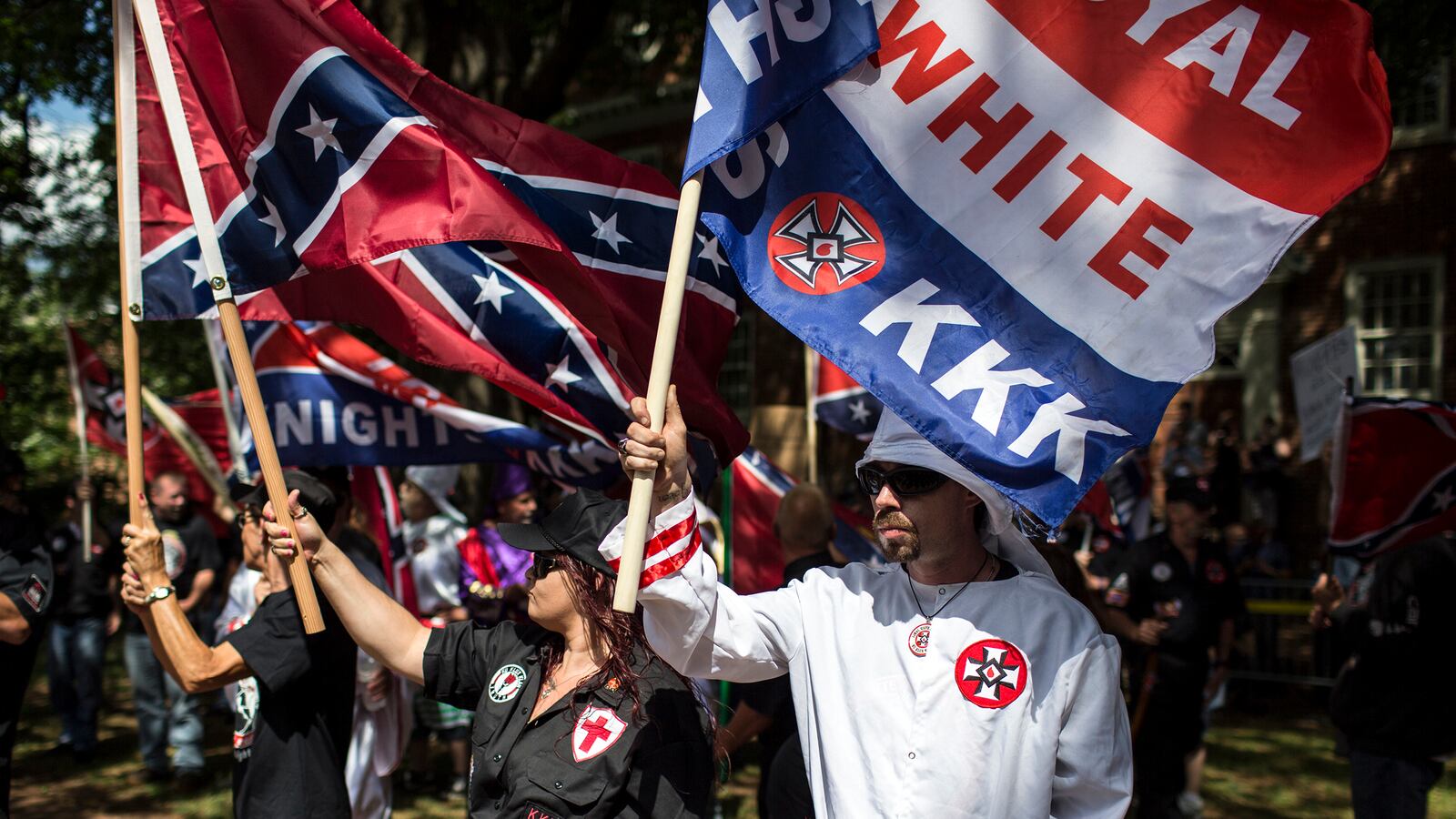With a president-backed “alt-right” holding torchlight parades and chanting “blood and soil,” could it finally be safe to disregard Godwin’s Law (with its caution against shark-jumping Hitler comparisons) and welcome “Nazi” full-on to the discourse?
Even Mike Godwin himself says we should call the Charlottesville marchers Nazis—“again and again.” Much as we prefer to fall back on our native mythology of a perennial civil war, Charlottesville seems less about Gettysburg 1863—or Birmingham 1963—than about Berlin 1932, when street skirmishes between fascists and anti-fascists were symptoms of a dying republic, not a fight to keep the union whole.
Rather than contradicting that template, the ouster of Steve Bannon, Donald Trump’s chief strategist and avatar of the white nationalists, eerily evokes events surrounding the Third Reich’s first major crisis, when Adolf Hitler was forced to tame the obstreperous revolutionaries of his base. Night of the Long Knives, meet the no-one-was-killed-in-the-making-of-this-reality-show Trump edition, Night of the Longest Knives the World Has Ever Seen, Believe Me.
To state my disclaimer as plainly as possible, 21st-century America is not 20th-century Germany, and historical analogies are inherently non-literal. But roots of both republican meltdowns can be found in the annals of global capitalism. As the stock market crash of 1929 expanded Germany’s National Socialist Party from a fanatical rump group into a plurality of desperate opportunists, so did the Great Recession of 2008—once it became apparent that no one who caused it would pay—lead to a state-altering uprising that we persist optimistically in calling populist.
Early antecedents of the foot soldiers protesting Robert E. Lee’s eviction from a Charlottesville park might be discerned in the German Freikorps that emerged from the First World War. There’s an economic parallel in that many members were former shock troops who could find no role in post-calamity society, as those said to be Trump’s most committed followers saw their skills and training marginalized in the modern economy.
And then there’s the psychic dimension. The German losers’ ultimate humiliation was the Versailles treaty’s War Guilt clause, blaming Germany unilaterally for the hostilities, and inflicting a spiritual wound much like what today’s assault on General Lee must feel like to American white nationalists. Lee seemed clean if not sacred, the South’s tragic hero, torn between two countries. At Appomattox, Grant famously let the surrendering general’s men take their horses for the spring planting. The present-day enemy, it seemed, would leave the neo-Confederates no relics of their dignity.
To maintain their self-esteem, the Freikorpsmen carried the violent, unreconstructed masculinity of wartime into what the Nazis considered a “syphilitic peace”—the louche, “effeminate,” cosmopolitan Weimar Republic—urging the country “from emasculation to new virility,” as Joseph Goebbels would put it, “from ruin to a reconquest of our German nationalism.”
They mastered the aesthetics of nationalist pride—brown uniforms, swastikas, heil salutes—even before evolving into the Brownshirts, or the SA, the Sturmabteilung of Adolf Hitler’s young movement in the 1920s. “So far from fear, so close to death—hail to you, SA!” Goebbels extolled the SA’s brawling spirit, while he himself flaunted his Heidelberg Ph.D. as the Nazis’ left-wing intellectual theorist, hammering the “bourgeois state” for “transforming the love of one’s ethnicity into a greedy love of wealth, excluding thereby 17 million German-feeling, German-thinking proletarians.” In a sign of the party’s schizoid appeal, one contemporary observer estimated that a third of the Brownshirts were former Leftists, with entire SA units consisting of ex-Communists— or Beefsteak Nazis, “Brown on the outside, Red inside.”
Certainly, violent, unhinged extremism is not a monopoly of the right, as a gunman demonstrated last month on an Alexandria, Va., ball field. Neither is boneheaded sectarianism. The German Communists’ excuse for not teaming up with the Social Democrats against the Nazis—“Nach Hitler, uns” (“After Hitler, us”)—found like minds in the Democrats’ Bernie-or-Bust wing.
But let’s be clear about the limits of “equivalency,” or the mirror-imaging of the Sanders-Trump coalitions: Socialism, to pick Bernie Sanders’s berth in what Trump is calling the “alt-left,” is based on coherent ideas and respect for universal human dignity, while fascism is sustained, at best, by fear-, hate-, and war-mongering. As for “policy,” the fascists’ main message was articulated in a Hitler speech from 1929: Germany “found herself in this swamp of party politics and parliamentarianism,” he said, and concluded with a sentiment later reprised by Bannon: “It is possible that a State may become so lazy and decayed that it is only in the interest of the people that it be eliminated.”
The most dynamic thing going for the Nazi Party when Hitler took power in 1933 was the ecstatic nihilism of the SA, promoting permanent revolution as a way of life. Chancellor Hitler soon faced a demagogue’s moment of truth: when overthrowing must yield to governing. “He only knows what he wants to destroy,” observed Otto Strasser, Goebbels’ fellow left-wing Party intellectual; “he pulls down the walls without any idea of what he will build in their place.” Under pressure from the “elites”—President Paul von Hindenburg (his titular superior), the industrialists, and the generals alarmed by the paramilitary SA—Hitler began “shifting to middle ground,” The New York Times observed in June 1934, predicting the inevitable pivot. Then he brutally purged the SA along with his political critics, including Strasser’s brother, who had called him a “congenital liar.” That orgy of summary execution went down in history as the Night of the Long Knives—and the creation of an unabashedly criminal state. “I gave the order to shoot those most guilty of this treason,” Hitler boasted. The base thanked him. Still, the foreign press mocked him as “little man” and “the house painter.”
Goebbels survived by tacking center (yes, I realize how weird that sounds) away from both Marxian doctrine and revolutionary paramilitarism. Bannon, the Trump White House’s Lenin-loving propagandist with a Harvard M.B.A., withstood the palace intrigue as long as he did because of, rather than despite, his street cred with the Republican Party radicals. Trump’s slowness to “purge” him reportedly reflected his fear of having Bannon outside the tent pissing in, as Hitler was afraid of the rogue SA leader Ernst Röhm, whom he opted to murder rather than fire.
I am mindful that this is a big difference: Obviously, the “alt-right” is no SA, despite its threats of revolution in the wake of Bannon’s dismissal. And Donald Trump, lest it need be said, is no Adolf Hitler—his scenario of shooting someone on Fifth Avenue was hypothetical, and he merely suggested that the “Second Amendment People” could deal with his political opponent. How astonishing, then, that he risked mortal injury to his presidency rather than repudiate his “collection of clowns,” as Bannon called the white supremacists, perhaps thereby doing his boss one last bad-cop favor before departing.
Before we proclaim the newest “pivot,” it might not be a bad idea to review what happened after Hitler brought the “clowns” of his party to heel. On August 2, 1934, a month after the Night of the Long Knives, the mostly decorative President von Hindenburg died. Hours later, in a stark break with the Prussian military tradition of “Überparteilichkeit (above-partisanship, with fealty only to the “Vaterland, the great idea”), the Wehrmacht generals who remained Hitler’s only obstacle to total dictatorship pledged “unqualified obedience” to the Austriancorporal. The very next day, Hitler made himself Führer, answerable to no one. In submission to the leader some 17 months earlier, the parliament had effectively dissolved itself during the “national emergency” caused by the Reichstag fire. Advise-and-consent equaled Hitler’s ego: “I cannot be mistaken. What I do and say is historical.”
Watching the anguished body language of General John Kelly, White House chief of staff, during the presidential come-apart at Trump Tower did not bring the same sense of relief as the stony demeanor of General Jim Mattis, Secretary of Defense, at the televised pledge of obedience Trump staged for his Cabinet in June. To rejoice over Kelly’s subsequent removal of Bannon is to “normalize” Trump’s appointment of such a frank propagandist in the first place. Yes, we commend our institutions for continuing to perform the checks and balances, but the spadework of totalitarianism proceeds. Another Harvard-educated member of Trump’s nativist task force, the Kansas Secretary of State Kris Kobach, has branched out from his “self-deportation” crusade against immigrants to creating a nationwide registry of citizens’ party affiliation and voting history—potentially a political-DNA version of Nazi Germany’s genealogical databank, enabling the easy identification of “undesirables.” The Sinclair Broadcast empire’s mandating of pro-Trump editorials on local stations—affiliates of historically neutral major networks—conjures a state propaganda apparatus worthy of Goebbels, who dismissed foreign press coverage of the persecution of German Jews as so much fake news (“atrocity propaganda”).
It is a testament to the power of fascism that many Germans kept faith with the Führer long after he had annihilated their own country along with millions of human beings—six million of them Jews, including forebears of Donald Trump’s grandchildren. “There will be another world coming for Germany, don’t you worry,” a well-fed Frau told Allied soldiers occupying her town on Hitler’s last birthday, April 20, 1945. “Der Führer is a quiet man. My birthday wishes for our Führer are in my heart. The subject is too sacred to discuss with you.” A few days later, Hanna Reitsch, the great aviator making her final visit to Hitler’s bunker in ruined Berlin, begged him to save himself. “‘The Führer must live, so that Germany can live,’” she said, quoting the Volk. When the Allies began circulating photographic evidence of the genocide, the defeated Germans’ response became a loving refrain: “Der Führer didn’t know.”
To be clear, Making America Great Again is in no way akin to Total War, let alone a Holocaust. But “we’re not as bad as Nazi Germany” isn’t our standard. The life force of democracy is a belief in the innate wisdom of the people, who will see the light, even if the operative word is “eventually.” The test of whether we are a people still deserving of that romantic notion is in Donald Trump’s polls, and the willingness of the enablers around him to follow this president, as a righteous German said of the capitulating Prussian generals, unto “moral suicide.”




